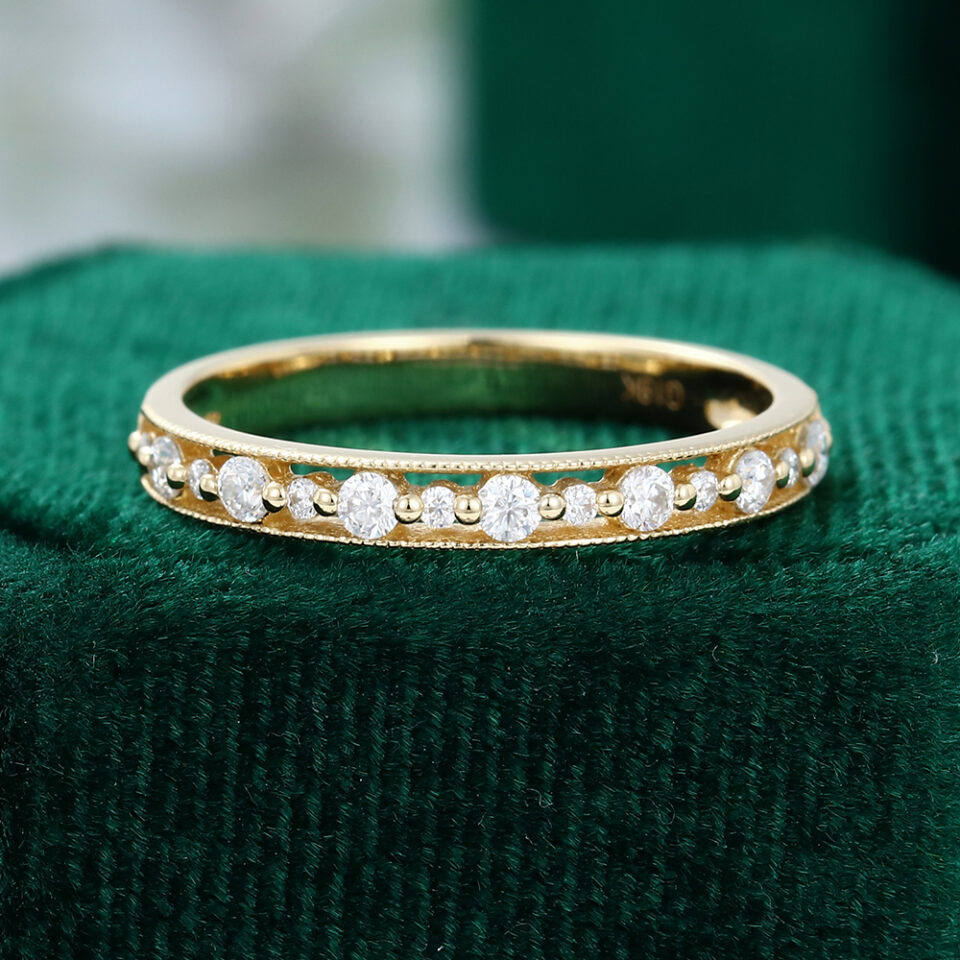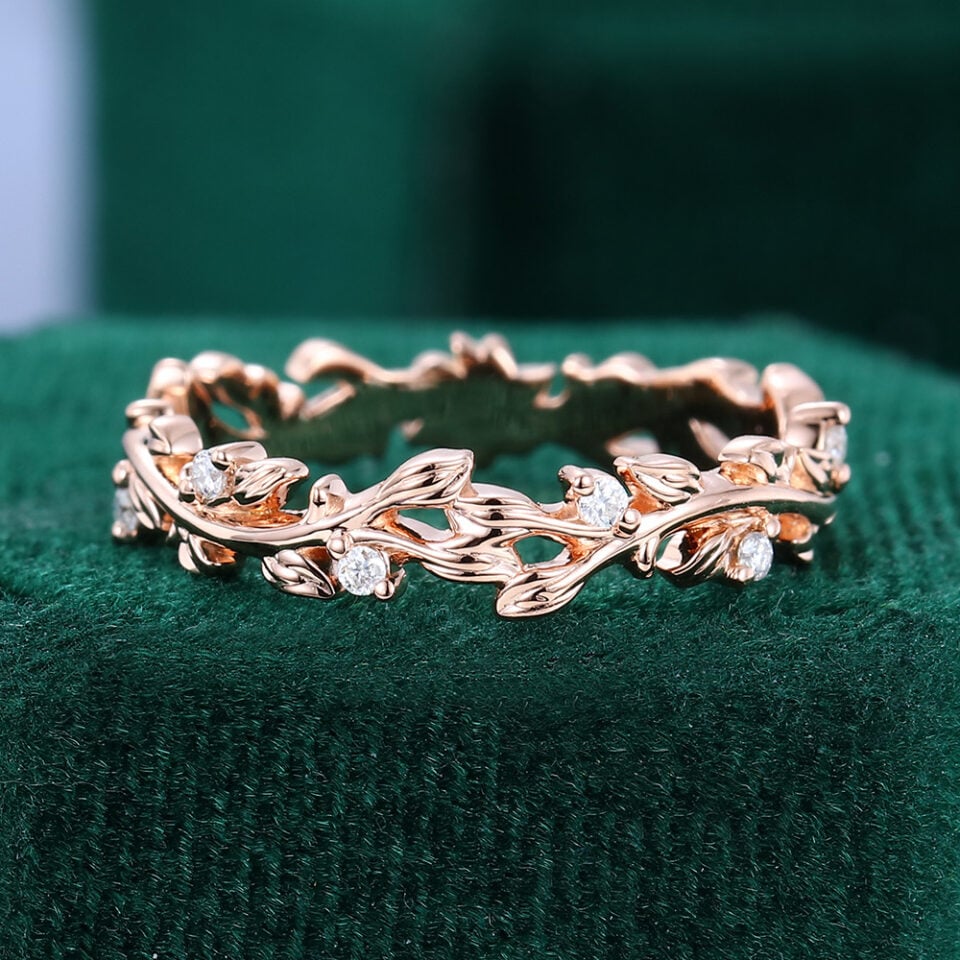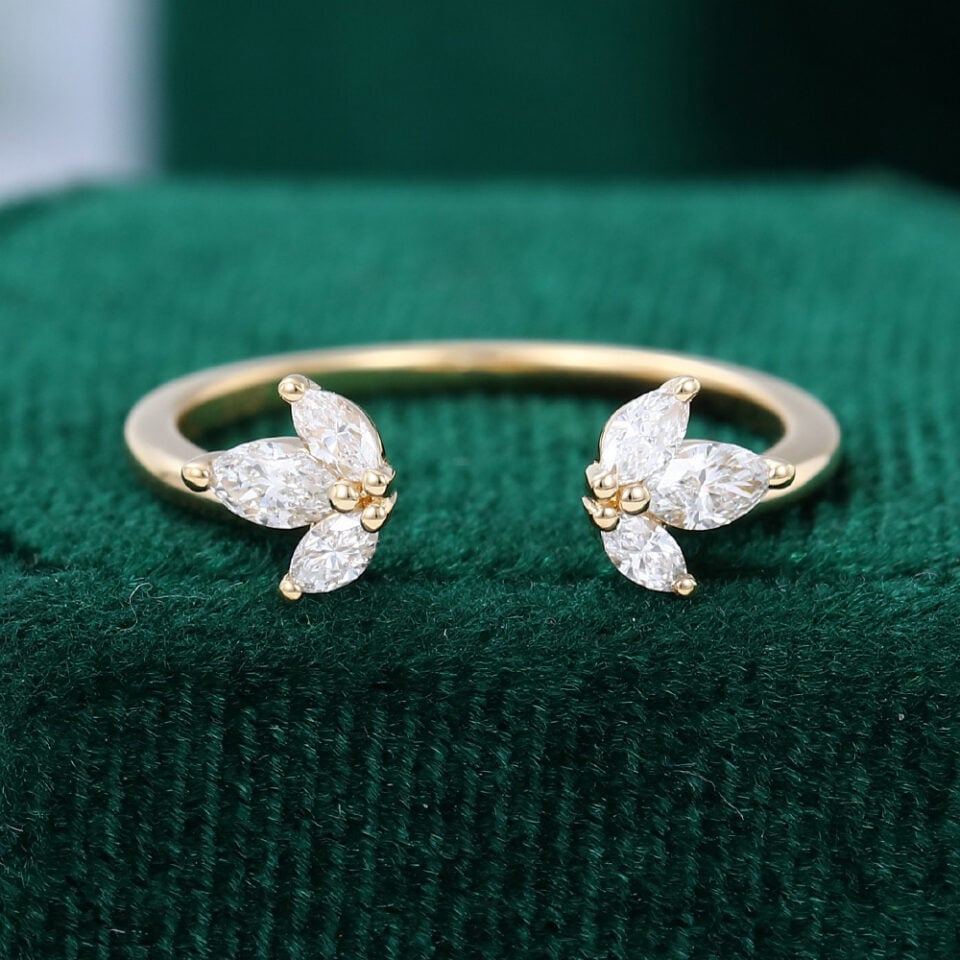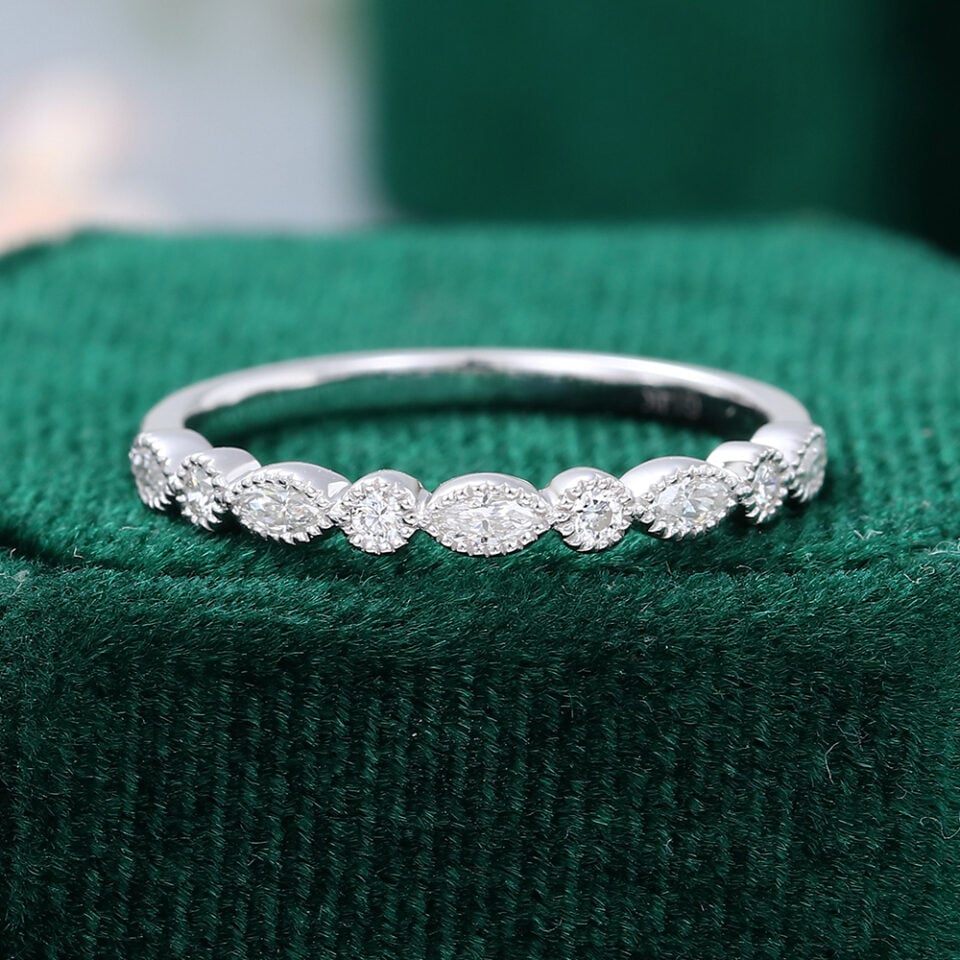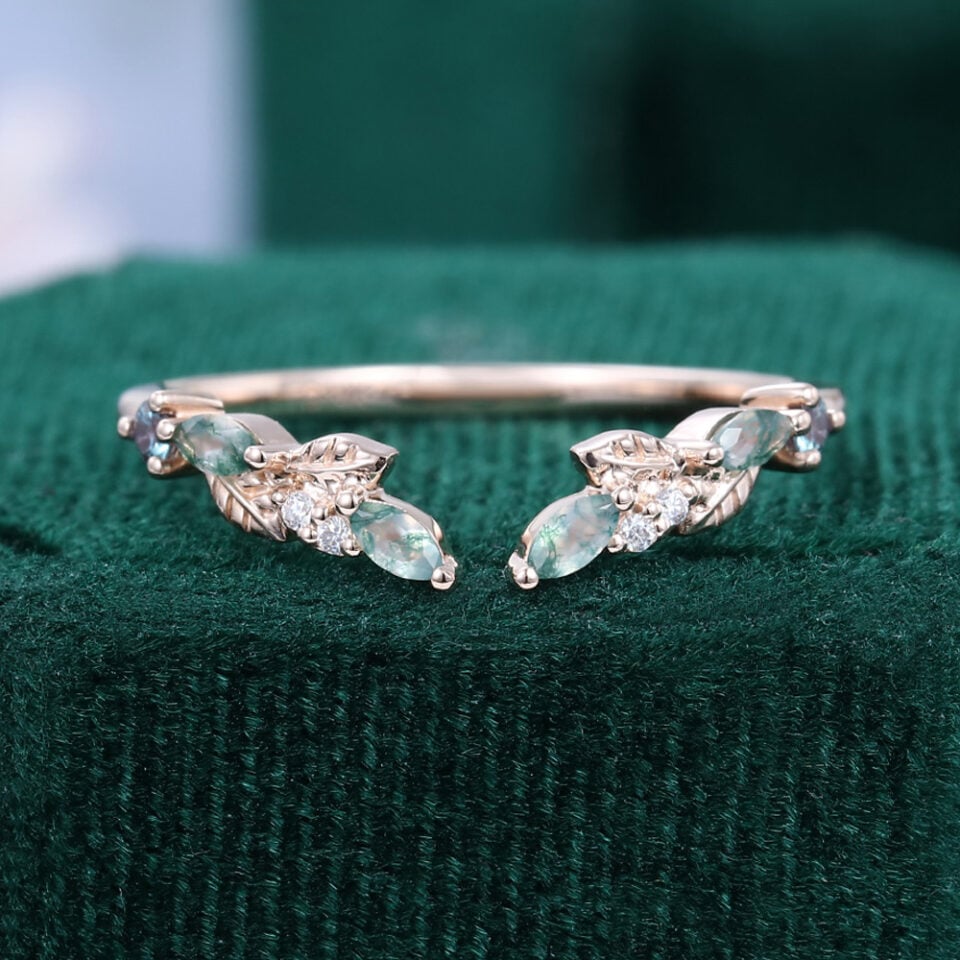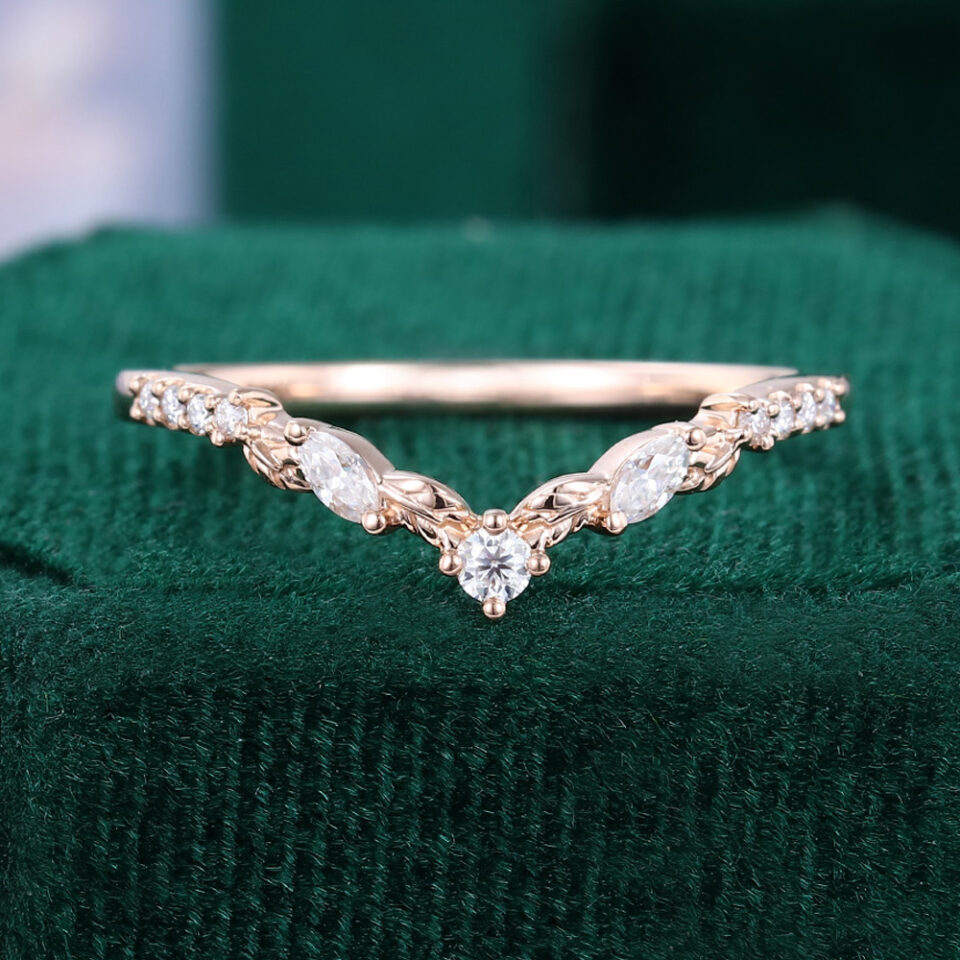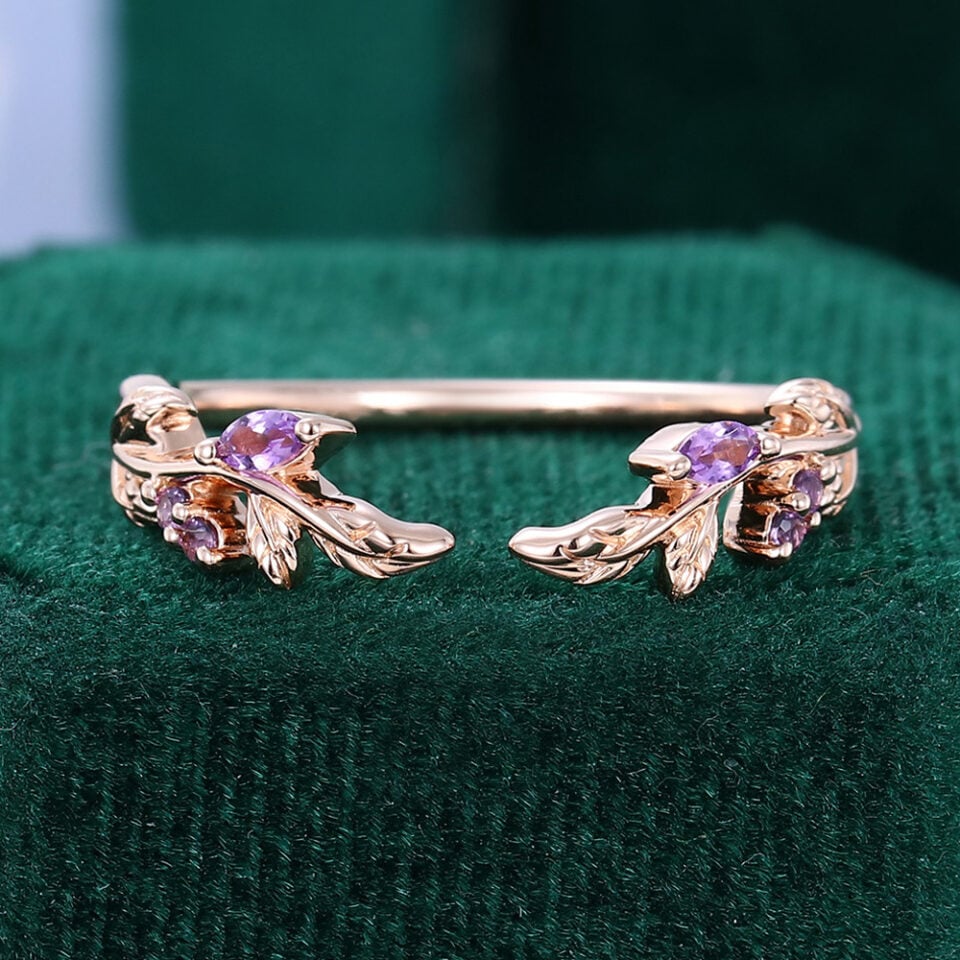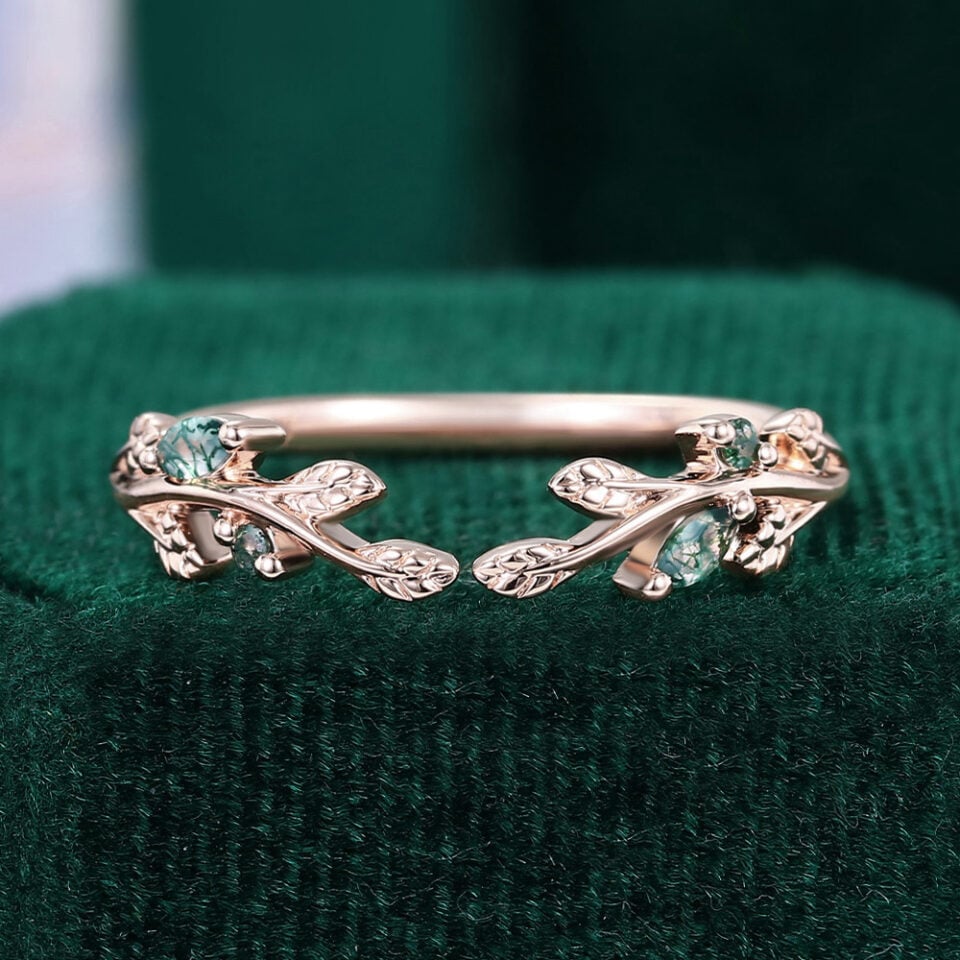- by MollyJewelryUS
- July 25, 2025
- Buying Guides
Are you considering creating the perfect bridal ring set by selecting the right wedding band?
Today, straight wedding bands and curved wedding bands are the two main design styles, each with its own unique appeal. Straight bands embody timeless simplicity — clean lines, timeless style, and high versatility. Curved bands, on the other hand, offer a more customized fit and are typically thoughtfully designed to complement your engagement ring seamlessly.
This guide will take a deep dive into the distinct characteristics, benefits, and practical considerations of both styles, including how each pairs with different types of engagement rings, their impact on comfort, and the deeper symbolic meanings they carry. After reading, you’ll have a clear idea of how to choose a wedding band that fits beautifully into your ring stack and reflects your personal story.
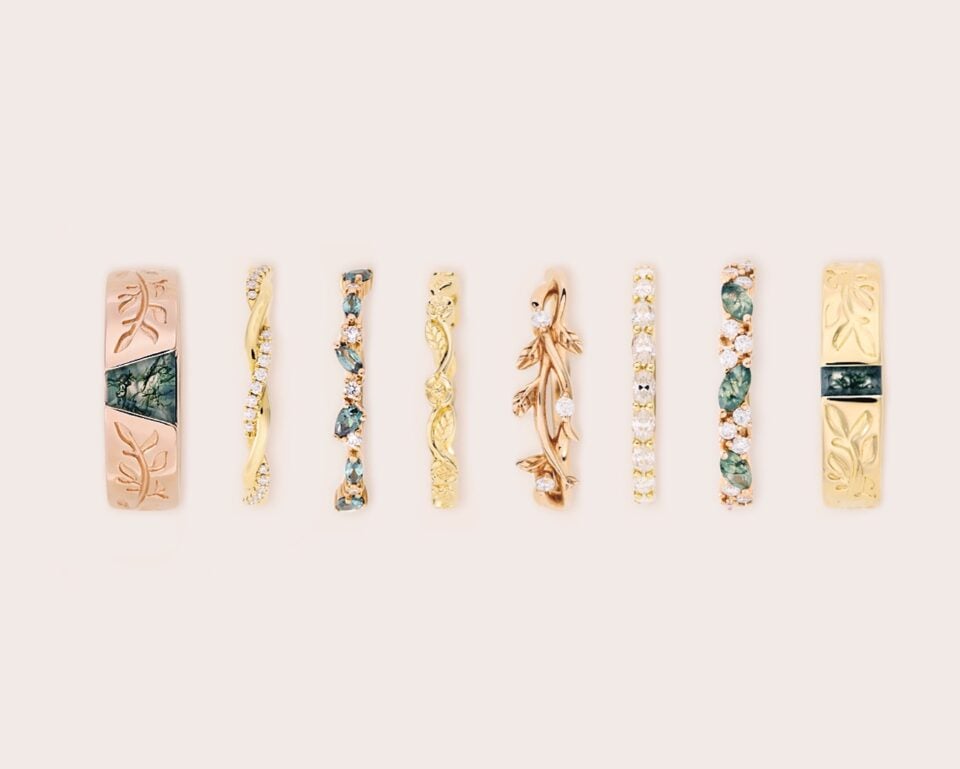
Table Of Contents:
- Straight Wedding Bands: Definition, Pros & Cons
- Curved Wedding Bands: Definition, Pros & Cons
- Straight vs. Curved Wedding Bands: A Side-by-Side Comparison
- Stacking with Engagement Ring: How to Choose?
What Is a Straight Wedding Band?
As the name suggests, a straight wedding band is defined by its straight shape and parallel sides — a highly classic band design. These rings can be simple metal bands or detailed with diamonds or other gemstones. Through different combinations of metals (like platinum or gold), finishes, and gemstone settings, a variety of styles can be created. Yet the foundation remains: clean lines that reflect timeless aesthetics.
Why Choose a Straight Wedding Band? — Key Benefits Explained
The enduring popularity of straight wedding bands stems from several standout qualities:
- Versatile and Practical
The straight-edge design offers both “stackability” and standalone beauty. It pairs harmoniously with engagement rings for a cohesive look, while also maintaining a polished, balanced appearance when worn alone. Perfect for both everyday wear and formal occasions. - Timeless Style
Rooted in minimalist, straight-line design and free of excessive ornamentation, straight wedding bands embody a classic elegance that transcends trends. Their clean silhouette consistently conveys a sense of poise and permanence — a fitting symbol of lasting commitment. - Cost-Effective and Budget-Friendly
Compared to curved bands — which often require custom shaping and involve more intricate craftsmanship — straight wedding bands are simpler to produce. Without the need for curvature adjustments, they offer high quality at a more accessible price, ideal for budget-conscious buyers. - Easy to Stack — Especially with High-Set Engagement Rings
For engagement rings with high-set center stones, a straight band’s flat profile can slide easily beneath the setting. This prevents gaps or misalignment and creates a seamless, layered look, all while minimizing wear-time inconvenience.
Considerations for Straight Wedding Bands (Potential Limitations)
- Possible Gaps When Stacked
If your engagement ring has a low-set stone, curved band, or detailed design, a straight wedding band may not sit flush, leaving a visible gap. This can affect the overall appearance and potentially lead to increased wear from friction over time. - Limited Design Compatibility
With fancy-shaped stones (like marquise or pear cuts) or asymmetrical band styles, the straight lines of a traditional band may clash with the design, reducing visual harmony. In such cases, a custom curved wedding band might be the better option.
What Is a Curved Wedding Band?
A curved wedding band is defined by its non-linear shape—featuring a curve or arc designed specifically to fit the contour of an engagement ring. Through its thoughtful curved design, the band wraps around the engagement ring naturally and connects seamlessly, creating a visually unified look when stacked together.
These wedding bands come in a wide variety of curve styles, including smooth U-shapes, graceful S-curves, sharp V-shapes, flowing wave-like forms, and even sculptural twisted designs. They can be adapted to complement your engagement ring’s features—such as the shape of the center stone and the lines of the band—enhancing both harmony and uniqueness in your bridal set.
Why Choose a Curved Wedding Band? — Key Benefits Explained
The appeal of a curved wedding band goes beyond aesthetics—it lies in the thoughtful balance of design and functionality:
- Flush Fit That Eliminates Gaps and Reduces Wear
This is perhaps the most standout benefit of curved bands—they are shaped to fit snugly against your engagement ring, eliminating awkward gaps and achieving a cohesive, seamless look. This close fit also minimizes friction between the two rings, helping reduce wear over time and extending the life of your jewelry. - Ergonomic Comfort
Curved lines follow the natural contour of your finger, offering a fit that conforms more closely to the hand. This helps distribute pressure more evenly and avoids the discomfort sometimes caused by straight-edged bands. - Enhances Design Harmony—Ideal for Intricate Engagement Rings
For engagement rings with low-set stones, halo settings, or fancy shapes like pear, marquise, or heart, a curved wedding band complements the ring’s unique outline. This interplay of lines enhances the set’s balance and adds visual layers and thoughtful design. - Visually Enhances Hand Shape
Certain curves—like S-shapes, V-shapes, or slender U-shapes—can create the illusion of longer, more graceful fingers. These styles serve both decorative and flattering purposes, appealing to those who want their rings to enhance the appearance of their hands.
Considerations for Curved Wedding Bands (Potential Drawbacks)
- Limited Versatility When Worn Alone
Most curved bands rely on the complementary fit with an engagement ring. Subtle curves can still look natural when worn solo, but more dramatic shapes—like deep U-curves or twisted designs—might appear unbalanced or awkward on their own. Those who prefer wearing only their wedding band at times should choose carefully. - Customization May Increase Cost
To achieve a perfect fit with a uniquely designed engagement ring, curved bands often require custom adjustments—such as tailoring the curve to match the center stone or band details. This customization can extend production time and may increase costs due to the added complexity.
Straight vs. Curved Wedding Bands: A Side-by-Side Comparison
The table below summarizes the key differences between straight and curved wedding bands.
| Feature | Straight Wedding Band | Curved Wedding Band |
|---|---|---|
| Fit (with Engagement Ring) | Sits flush with high-set engagement rings | Custom-contoured to eliminate gaps and hug the engagement ring closely |
| Wearability (Alone) | Ideal for solo wear (looks complete) | May look incomplete when worn alone (depends on the curve) |
| Budget | Generally more affordable | May require custom design (higher cost) |
| Comfort | Standard ergonomic comfort | Enhanced ergonomic comfort |
| Best Match For | High-set solitaires, simple settings | Low-set stones, halo settings, fancy shapes, intricate designs |
| Maintenance / Durability | Low maintenance (plain); diamond versions need more care | Helps protect center stones; similar maintenance needs to diamond straight bands |
| Symbolism | Directness, steadfast commitment | Flexibility, growth, unity, enduring bond |
1. Fit (with Engagement Ring)
Straight wedding bands pair well with high-set engagement rings, aligning neatly with their lines.
Curved bands can be custom-shaped to sit flush with the engagement ring, eliminating any gaps and creating a seamless look.
2. Style / Aesthetics
Straight bands focus on timeless minimalism with clean lines, offering both classic and modern simplicity.
Curved bands have a more dynamic, romantic, and contemporary aesthetic. They emphasize harmony in stacking and enhance the unique beauty of engagement rings.
3. Budget
Straight bands are generally more budget-friendly due to their simpler design and production process, with no need for complex curve adjustments.
Curved bands often require custom shaping, especially when made to fit a unique engagement ring. This can involve more design work and labor, making them more expensive.
4. Wearability (Alone)
Straight bands maintain a complete, visually balanced look when worn alone, making them ideal for everyday solo wear.
Curved bands may vary—those with subtle curves can still appear natural when worn alone, while more dramatic curves (like deep U-shapes or twists) might look awkward or unfinished.
5. Comfort
Straight bands follow basic ergonomic standards and are generally comfortable for daily wear.
Curved bands conform more closely to the natural contour of the finger, offering superior comfort—especially for active lifestyles.
6. Best Matches
Straight bands pair best with high-set solitaires or simple engagement rings (like six-prong settings).
Curved bands are ideal for low-set stones, halo designs, fancy shapes (like pear or marquise), and more complex settings.
7. Maintenance / Durability
Plain straight bands require minimal upkeep—just avoid impacts and harsh chemicals. Diamond-set versions need regular checks to ensure stone security.
Curved bands’ snug fit reduces friction with engagement rings, offering indirect protection for center stones. Maintenance needs are similar to straight bands with diamonds.
8. Symbolic Meaning
Straight bands represent directness and a steadfast promise—symbolizing eternal love and pure intention. Their simplicity reflects clarity and sincerity in commitment.
Curved bands, with their gentle arcs, symbolize flexibility, resilience, and the journey of growing together through life’s ups and downs. They can also represent two individual paths gracefully bending and joining as one.
The “steadfastness” of straight bands and the “adaptability” of curved bands are not in conflict but offer different expressions of commitment—one rooted in unchanging devotion, the other in shared evolution. You can choose based on your personal emotional preferences.
Stacking with Your Engagement Ring: How to Choose the Right Wedding Band?
When selecting a wedding band, beyond comfort, personal preference, and budget, the design details of your engagement ring are key factors that determine how well the bands pair together. Below is an analysis of the core considerations for compatibility, along with specific pairing suggestions.
1. Core Factors Influencing Wedding Band Choice
1.1. Engagement Ring Setting Height
The setting height directly affects whether the wedding band can sit “flush and seamless”:
- High-Set Rings (such as classic six-prong solitaires): The center stone’s base is raised, leaving enough space underneath. A straight wedding band can easily slide under for a flush fit, avoiding gaps and achieving perfect alignment.
- Low-Set Rings (where the stone sits close to the band/finger): The base is nearly level with the band surface, making it harder for a straight band to fit without gaps or catching. Curved, open, or custom bands that wrap around the base are needed to nest the rings smoothly.
Related reading: High-Set vs. Low-Set Engagement Rings
1.2. Shape of the Engagement Ring’s Center Stone and Decorative Elements
Besides setting height, the shape and details of the stone also play important roles:
- Fancy-Cut Stones (heart, pear, marquise): Irregular edges (like the pointed tip of a pear or the tapered ends of a marquise) require wedding bands with curves (such as V-shapes or arcs) or open designs to “avoid” these points and prevent clashing lines.
- Intricate Settings (halo, side stones, twisted bands): Raised details on the base or band can cause friction with a straight band. Curved or notched bands better conform to these contours, enhancing overall harmony.
1.3. Engagement Ring Band Design
If the engagement ring’s band features twists, natural textures (like vine patterns), or other unique designs, the wedding band should echo these curves (such as a custom curved band in the same style) to strengthen visual unity through matching lines.
2. Engagement Ring Styles and Recommended Wedding Band Pairings
| Engagement Ring Style/Feature | Recommended Wedding Band Type | Reason/Benefit |
| High-Set Solitaire | Straight edge, thin plain or pavé | Allows for flush fit and classic look |
| Low-Set Solitaire | Gentle curves, open bands, custom curved | Prevents gaps, achieves perfect nesting |
| Halo Setting | Curved, notched, custom curved | Fits closely around halo, enhances beauty |
| Oval Cut | Curved, thin plain/pavé, oval-accented diamonds | Matches gemstone shape, maintains refined appearance, coordinated look |
| Pear Cut | Curved, chevron/V-shape, open bands, pear-accented diamonds | Frames pointed tip, allows space for stone’s point, echoes shape |
| Marquise Cut | Chevron/V-shape, open bands, ring guards/stackable sets | Frames pointed ends, allows room, embraces shape |
| Heart Cut | Curved, notched, simple thin bands, delicate pavé | Fits snugly, preserves heart focal point, adds sparkle |
| Cushion Cut | Curved, vintage styles (milgrain/engraving), geometric | Complements rounded corners, enhances vintage charm, offers contrast |
| Asscher/Emerald Cut | Flat polished, channel set, long step-cut, bezel eternity bands | Sophisticated geometric look, echoes step facets, modern contrast |
| Twisted/Unique Engagement Bands | Custom curved, mimicking curves | Enhances visual harmony, ensures perfect fit |
3. Beyond Curved and Straight: Other Practical Options
While straight and curved bands dominate the conversation, other styles and traditions deserve brief mention.
Open Bands
- Key Benefit: Feature an open gap in the band, allowing flexible fit for low-set, geometric, or unusual engagement rings by adjusting the opening width to fit the base, reducing gaps; also serve as “transition bands” to ease stacking tightness.
- Ideal Use: For uniquely designed engagement rings that are difficult to match with curved bands.
Ring Enhancers
- Design Features: Made specifically for certain engagement rings, usually wrap-around or half-wrap styles that encircle the center stone or band. They use pavé diamonds or complementary curves to “enhance” the original ring’s glamour while solving stacking fit issues.
- Ideal Use: For those wanting to boost the engagement ring’s visual impact and achieve an integrated stacked look.
The core of choosing a wedding band is “complement and compatibility”: a deeply personal process that weaves together aesthetics, comfort, and meaningful symbolism. There is no single “right” answer; the best choice depends entirely on the unique combination of factors — the specific design of your engagement ring, your daily lifestyle and comfort needs, your personal style and preferences, and the symbolism that resonates most with you.
So, have you figured out which type of wedding band is right for you? Explore MollyJewelryUS, we offer a wide range of straight and curved wedding bands, from classic plain styles to those adorned with diamonds or gemstones. You’re sure to find the one that speaks to you.
